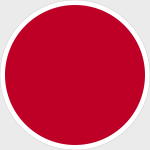Corgi AA33107 Imperial Japanese Navy Mitusbishi A6M3-22 Zero Fighter - Pilot PO2/c Shoichi Sugita, 204th Kokutai, Lakunai A/D, Rabaul, New Britain, 1943 (1:72 Scale)
"We have resolved to endure the unendurable and suffer what is insufferable."
- Japanese Emperor Hirohito, after the Hiroshima bombing
 The Mitsubishi A6M "Zero" is a long-range carrier-based fighter aircraft formerly manufactured by Mitsubishi Aircraft Company, a part of Mitsubishi Heavy Industries. It was operated by the Imperial Japanese Navy (IJN) from 1940 to 1945. The A6M was designated as the Mitsubishi Navy Type 0 carrier fighter, or the Mitsubishi A6M Rei-sen. The A6M was usually referred to by its pilots as the Reisen (zero fighter), "0" being the last digit of the imperial year 2600 (1940) when it entered service with the Imperial Navy. The official Allied reporting name was "Zeke", although the name "Zero" was used colloquially as well.
The Mitsubishi A6M "Zero" is a long-range carrier-based fighter aircraft formerly manufactured by Mitsubishi Aircraft Company, a part of Mitsubishi Heavy Industries. It was operated by the Imperial Japanese Navy (IJN) from 1940 to 1945. The A6M was designated as the Mitsubishi Navy Type 0 carrier fighter, or the Mitsubishi A6M Rei-sen. The A6M was usually referred to by its pilots as the Reisen (zero fighter), "0" being the last digit of the imperial year 2600 (1940) when it entered service with the Imperial Navy. The official Allied reporting name was "Zeke", although the name "Zero" was used colloquially as well.
The Zero is considered to have been the most capable carrier-based fighter in the world when it was introduced early in World War II, combining excellent maneuverability and very long range. The Imperial Japanese Navy Air Service also frequently used it as a land-based fighter.
In early combat operations, the Zero gained a reputation as a dogfighter, achieving an outstanding kill ratio of 12 to 1, but by mid-1942 a combination of new tactics and the introduction of better equipment enabled Allied pilots to engage the Zero on generally equal terms. By 1943, the Zero was less effective against newer Allied fighters. The Zero lacked hydraulic boosting for its ailerons and rudder, rendering it difficult to maneuver at high speeds. Lack of self-sealing fuel tanks also made it more vulnerable than its contemporaries. By 1944, with Allied fighters approaching the A6M's levels of maneuverability and consistently exceeding its firepower, armor, and speed, the A6M had largely become outdated as a fighter aircraft. However, as design delays and production difficulties hampered the introduction of newer Japanese aircraft models, the Zero continued to serve in a front-line role until the end of the war in the Pacific. During the final phases, it was also adapted for use in kamikaze operations. Japan produced more Zeros than any other model of combat aircraft during the war.
This particular 1:72 scale replica of a Mitsubishi "Zero" fighter was flown by Pilot PO2/c Shoichi Sugita, of the 204th Kokutai, based at Lakunai A/D (Rabaul East) Rabaul, New Britain, in 1943.
Sold Out!
Dimensions:
Wingspan: 6-1/2-inches
Length: 6-inches
Release Date: November 2005
Historical Account: "Honor Guard" - In April 1943, Sugita was selected to escort the Betty bombers carrying the Admiral Isoroku Yamamoto and his staff. They were ambushed by P-38ís and the bombers were destroyed. In the dogfight that ensued, Sugita hit and damaged a P-38. But the air victory rang hollow, because Sugita blamed himself for the loss of the Admiral. Given every chance to redeem their honor, the escort pilots threw all caution to the wind. Sugita relished the increasing combat, and he honed his already impressive skills to the point where he became the deadliest of foes. Sugita became the top ace of the 204th Kokutai and was one of the JNAF's top scoring pilots.


